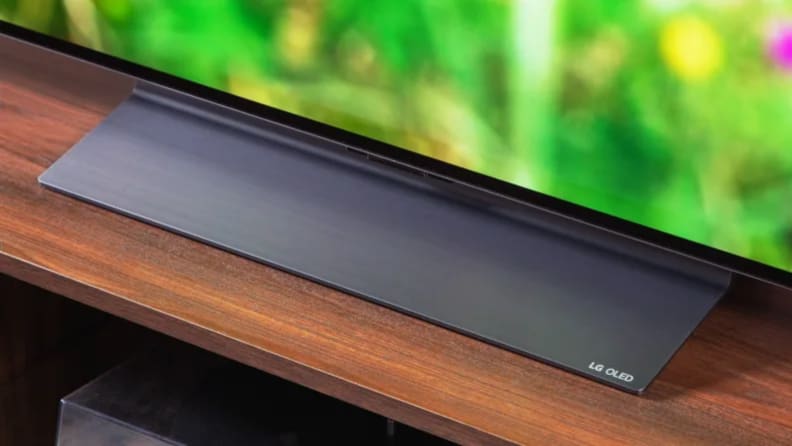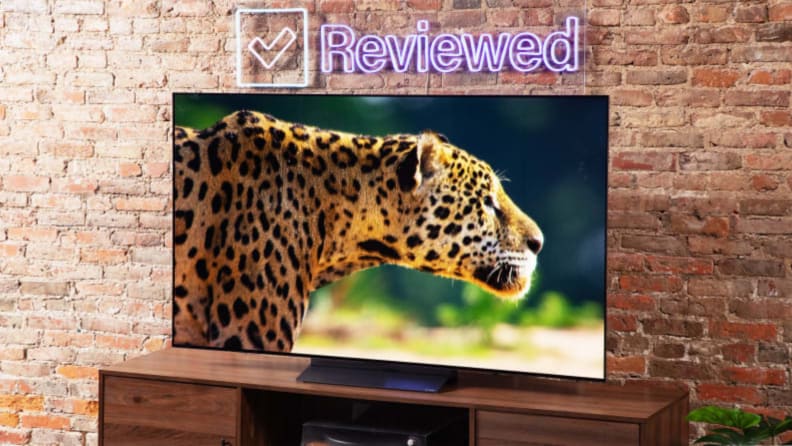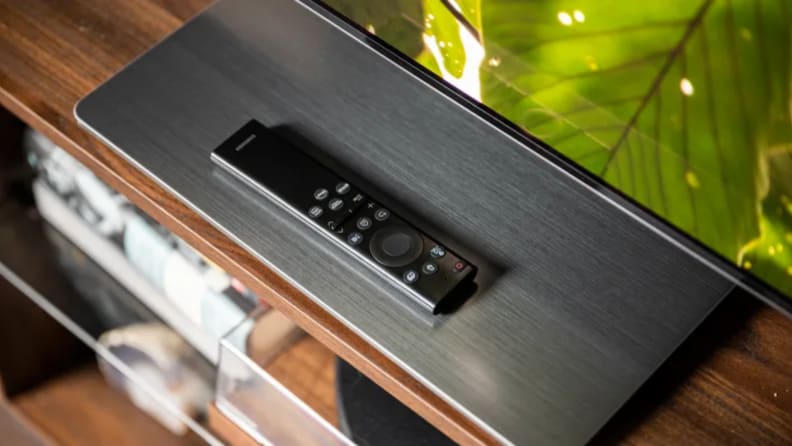As satisfying as it can be to treat yourself to new tech, there’s a world of savings waiting if you’re savvy enough to shop last year’s models. The LG C3 is brand-new for 2023, and it’s shaping up to be one of the year’s best TVs. It shares shelf space with the Samsung S95B, a similar TV in many ways, and one of the best releases of 2022. Being a year older, the Samsung is on sale pretty much everywhere it’s sold. But what would you be missing out on if you didn’t buy the newer LG C3?
We’ve spent a considerable amount of time asking ourselves this very question, and after testing both the LG C3 and the Samsung S95B extensively, we’re well positioned to get to the bottom of it. Here’s how these two OLED TVs compare, from price to performance.
Buy the Samsung S95B at Amazon
Price

Credit:
Reviewed / Betsey Goldwasser
Samsung’s S95B is only available in two sizes, 55 and 65 inches.
Perhaps the most consequential distinction between the LG C3 and the Samsung S95B concerns their respective lineups. Being a brand new TV, the C3 is not currently discounted. It’s also available in more sizes than its competitor.
LG C3:
- 42-inch (LG OLED42C3PUA), MSRP $1,399.99
- 48-inch (LG OLED48C3PUA), MSRP $1,499.99
- 55-inch (LG OLED55C3PUA), MSRP $1,899.99
- 65-inch (LG OLED65C3PUA), MSRP $2,600
- 77-inch (LG OLED77C3PUA), MSRP $3,599.99
- 83-inch (LG OLED83C3PUA), MSRP $5,299.99
The C3 is available in six sizes ranging from 42 to 83 inches. The 55-inch model will set you back $1,900, while the smallest size in the series costs $1,400.
The S95B, on the other hand, is only available in two sizes. The good news is that they’re two of the most popular TV sizes, and both are heavily discounted, given the TV’s year-old status.
Samsung S95B:
Those shopping for a TV bigger than 65 inches or smaller than 55 inches won’t find what they’re looking for in the S95B. The 55- and 65-inch, though, are available for a slam-dunk bargain; the 55-inch S95B can be bought for around $1,200, while the 65-inch model is available for just under $1,800.
While size availability is important, the S95B’s current sale prices are undeniably alluring. Look at it this way: The 55-inch S95B is currently more affordable than the 42-inch C3. That’s a great deal.
Our pick: Samsung S95B
Design

Credit:
Reviewed / Timothy Renzi
Both TVs use a pedestal stand and are incredibly thin.
One of the many features that set OLED TVs apart from the crowd are their ultra-thin panels. The C3 and S95B are remarkably thin, since their display technology has no need for a bulky backlight. At its narrowest point, the S95B is thinner than the C3 by a hair, and both TVs house their inputs and internals in a compact chassis around their midsection.
The C3 is built with a lightweight, composite-fiber material, making setup and repositioning relatively easy. The S95B is lightweight, too, just not as lightweight as the C3 when both are outfitted with their stands.
Both TVs rely on a pedestal-style stand; the S95B offers about three inches of soundbar clearance while the C3 offers roughly two inches. I prefer the downward-facing angle of the C3’s stand, but the S95B’s stand is a touch more accommodating.
The C3 is lighter and features a slightly more eye-catching stand. The S95B is a little more accommodating for soundbar owners. This category comes down to personal preference.
Our pick: Draw
Features and smart platform

Credit:
Reviewed / Timothy Renzi
Thanks to OLED technology, both TVs boast incredible contrast ratio and excellent specular highlights.
There are some key differences in these TVs’ hardware- and software-related features. Before I explain what sets them apart, let’s have a look at the features they share.
Both TVs can decode Dolby Atmos audio natively or pass it via eARC to Dolby Atmos soundbars—either uncompressed (Dolby TrueHD) or compressed (Dolby Digital Plus). However, of the two, only the LG C3 supports DTS audio.
The LG C3 also has the benefit of supporting Dolby Vision, a popular, proprietary HDR format. Like all Samsung TVs, the S95B doesn’t support HDR content mastered for Dolby Vision, opting instead for HDR10+, a format that operates in largely the same manner by using dynamic metadata to optimize the picture on a scene-by-scene or frame-by-frame basis. Some UHD Blu-rays and streaming platforms master content for HDR10+ (Amazon Prime being one of them), but Dolby Vision is the more prolific format. There are many Xbox Series X video games mastered for Dolby Vision, for example, and the LG C3 is the only one of these two TVs capable of presenting them in their native format.
On the gaming side of things, it’s neck and neck. Each TV supports Variable Refresh Rate (VRR) and Auto Low Latency Mode (ALLM) for smooth, low-latency gaming. All four of the HDMI inputs on both TVs support 4K gaming at 120Hz, which means you can connect up to three devices to game-optimized inputs and reserve the eARC-enabled input for a soundbar.
Additionally, the C3 and S95B each offer a dedicated gaming menu (LG’s Game Optimizer and Samsung’s Game Bar) so adjustments can be made on the fly to the performance or picture. They’re comparable in functionality, though I prefer the layout of LG’s Game Bar.
The S95B is also equipped Samsung Gaming Hub, a software suite featuring several cloud gaming services, including Nvidia GeForce Now and Xbox Cloud Gaming. The Gaming Hub lets you stream video games right to your TV without a console. We found there to be some network issues when we went hands-on with Samsung Gaming Hub last year, but it’s a nice feature to have in your back pocket, especially if the service improves with time.
Finally, let’s talk about smart platforms. The C3 comes with the newest version of LG’s smart platform (webOS 23) preinstalled, while the S95B is running last year’s version of Samsung’s smart platform, Smart Hub. Both platforms are laid out in a similar manner, with a dedicated home screen acting as the starting point for selecting content. There’s a considerable amount of sponsored and recommended content on each platform, too, though I found Samsung’s Smart Hub to be worse in this regard.
When it comes to basic navigation, the LG C3 has an edge. The S95B often slows down and stutters as you’re scrolling through menus, and it often takes more than one button press for a selection to register. The layout of the S95B’s menus can be confusing, too; basic tasks like changing inputs require one or two more steps than they ought to.
Between the C3’s Dolby Vision support and its superior software, this category is a clear winner for LG’s OLED.
Our pick: LG C3
Performance

Credit:
Reviewed / Betsey Goldwasser
The Samsung S95B was the first OLED released to include quantum dot technology.
The C3 and S95B both offer the highly valuable benefits we’ve come to expect from OLED TVs: picture-perfect black levels, rich, voluminous color, smooth motion handling, and incredibly wide viewing angles. These qualities are what make the display technology so popular with A/V enthusiasts.
When it was released last year, the S95B was the first of its type: an OLED TV with added quantum dots. They’re nanocrystals that emit red or green light when struck with blue light, and they’re the reason the S95B doesn’t need to rely on a color filter and additional white pixel like the C3. Without the color filter, the S95B is capable of getting brighter (and more colorful) than most of the TVs in its class.
While both TVs offer an incredible, world-class picture quality, the S95B is significantly brighter in HDR than the C3. In its most accurate picture mode, the S95B stops just short of 1,200 nits in HDR. When paired with perfect black levels, these scintillating highlights provide an awesome sense of depth. The C3 is no slouch (I measured similar HDR patterns at around 800 nits), but the added pop on the S95B can really make a difference when watching content mastered for HDR.
Colors on the S95B are improved by the addition of quantum dots, too—but the LG C3 isn’t far behind. Both TVs cover about 99% of the HDR color gamut (DCI-P3), but the S95B offers a bit more oomph in its primary colors, which look tremendously vibrant across all content types.
I am, however, more impressed with LG’s picture processing in the C3. For one thing, the C3’s updated picture processing enhances perceived brightness by analyzing the image and emphasizing brighter elements, and I truly believe it has a positive impact on the C3’s picture, as it closes the perceptible gap in brightness between the C3 and S95B.
I also find that the C3 looks much better in its Game Optimizer mode than the S95B does in Samsung’s Game Mode. And, while I loved how accurate Samsung’s Filmmaker mode is in the follow-up S95C, Filmmaker mode on the S95B isn’t quite as accurate as Filmmaker mode on the C3.
If all you’re looking for is souped-up brightness and psychedelic colors, the S95B is the way to go. But peak brightness isn’t everything, and the C3 is a steady performer across all content types, thanks to some superb engineering. Once again, this one is too close to call.
Our pick: Draw
And the winner is…

Credit:
Reviewed / Betsey Goldwasser
Even though it’s a 2022 model, the S95B still delivers stellar performance, and can be found at a bargain.
For most people, the Samsung S95B is a better pick than the LG C3. Why? It all comes down to price. The S95B is available for $600 to $1,100 less than the C3, depending on which size you buy and which vendor you buy it from. Other than size availability and Dolby Vision support, none of their differences—from features to performance—are more significant than $600 to $1,100.
That said, if you want a TV outside of the 55- to 65-inch range, if you value Dolby Vision, or if you just can’t bring yourself to splash out on a year-old TV, the LG C3 is an excellent choice. It’s already a contender for the best TV of the year.
One last note on the S95B: As Samsung’s newest TVs begin to roll out, S95B stock is fading fast. If you’re interested in saving some cash and picking one up, I recommend doing it sooner than later.

Samsung S95B OLED TV
The Samsung S95B is the first of its kind: an OLED TV that also features quantum dots.

LG C3 OLED TV
The LG C Series OLED returns with incredible contrast, vivid and accurate color, and gaming features galore.
The product experts at Reviewed have all your shopping needs covered. Follow Reviewed on Facebook, Twitter, Instagram, TikTok, or Flipboard for the latest deals, product reviews, and more.
Prices were accurate at the time this article was published but may change over time.









